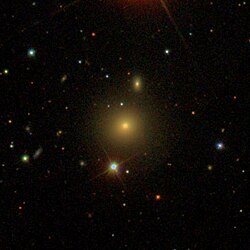| NGC 6263 | |
|---|---|
 SDSS image of NGC 6263 | |
| Observation data (J2000 epoch) | |
| Constellation | Hercules |
| Right ascension | 16h 56m 43.239s[1] |
| Declination | +27° 49′ 19.96″[1] |
| Redshift | 0.034541±0.000120 km/s[2] |
| Distance | 473.9 million light years (118.03 Mpc)[3][failed verification] |
| Apparent magnitude (V) | 14.1 |
| Characteristics | |
| Type | E[1] |
| Size | 124,000 light years |
| Apparent size (V) | 0.843′ × 0.742′[1] |
| Other designations | |
| LEDA 59292, UZC J165643.2+274919, AWM 5-4, 2MASX J16564323+2749199, Z 1654.7+2754, FBQS J1656+2749, MCG+05-40-008, Z 169-14, FIRST J165643.1+274919, NPM1G +27.0546, GIN 627, UGC 10618[1] | |
NGC 6263 is an elliptical galaxy in the constellation Hercules. It was discovered by Albert Marth on June 28, 1864.[4]
References[edit]
- ^ a b c d e Skrutskie, Michael F.; Cutri, Roc M.; Stiening, Rae; Weinberg, Martin D.; Schneider, Stephen E.; Carpenter, John M.; Beichman, Charles A.; Capps, Richard W.; Chester, Thomas; Elias, Jonathan H.; Huchra, John P.; Liebert, James W.; Lonsdale, Carol J.; Monet, David G.; Price, Stephan; Seitzer, Patrick; Jarrett, Thomas H.; Kirkpatrick, J. Davy; Gizis, John E.; Howard, Elizabeth V.; Evans, Tracey E.; Fowler, John W.; Fullmer, Linda; Hurt, Robert L.; Light, Robert M.; Kopan, Eugene L.; Marsh, Kenneth A.; McCallon, Howard L.; Tam, Robert; Van Dyk, Schuyler D.; Wheelock, Sherry L. (1 February 2006). "The Two Micron All Sky Survey (2MASS)". The Astronomical Journal. 131 (2): 1163–1183. Bibcode:2006AJ....131.1163S. doi:10.1086/498708. ISSN 0004-6256. S2CID 18913331.
- ^ Koranyi, Daniel M.; Geller, Margaret J. (January 2002), "Kinematics of AWM and MKW Poor Clusters", The Astronomical Journal, 123 (1): 100–124, Bibcode:2002AJ....123..100K, doi:10.1086/338096, S2CID 121962934
- ^ Tully, R. Brent; et al. (October 2013), "Cosmicflows-2: The Data", The Astronomical Journal, 146 (4): 25, arXiv:1307.7213, Bibcode:2013AJ....146...86T, doi:10.1088/0004-6256/146/4/86, S2CID 118494842, 86
- ^ Seligman, Courtney. "NGC Objects: NGC 6250 - 6299". cseligman.com. Archived from the original on 10 September 2015. Retrieved 3 July 2015.
External links[edit]
Well, that’s interesting to know that Psilotum nudum are known as whisk ferns. Psilotum nudum is the commoner species of the two. While the P. flaccidum is a rare species and is found in the tropical islands. Both the species are usually epiphytic in habit and grow upon tree ferns. These species may also be terrestrial and grow in humus or in the crevices of the rocks.
View the detailed Guide of Psilotum nudum: Detailed Study Of Psilotum Nudum (Whisk Fern), Classification, Anatomy, Reproduction